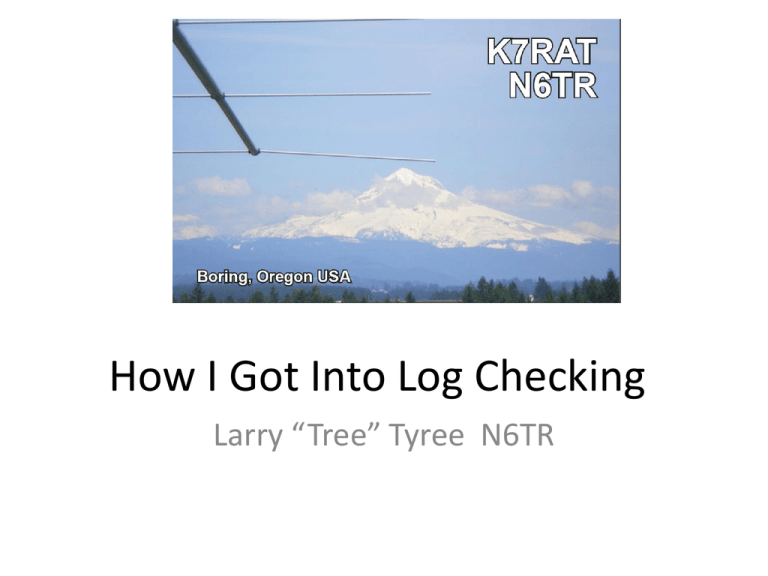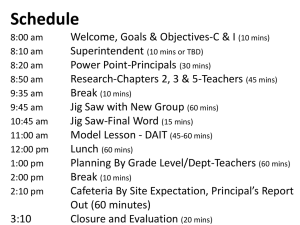How I Got Into Log Checking
advertisement

How I Got Into Log Checking Larry “Tree” Tyree N6TR Early Ham Years • First licensed in 1967 – Received FCC notice for 2nd harmonic on 14351 kHz. – Worked 313 stations before getting my General. • 1968 – First Contest – Field Day @ W6MN • 1971 – Annoyed my physics teacher enough that he sent me off to a Fortran class at the local Junior College during my last year of high school. – Wrote a program to compute prime numbers up to 1000 (on punch cards). – Stopped running it at 500 after 35 minutes. Basic, Pascal and the N6TR Duping Service • In the late 1970s, I learned how to program using Basic on a CP/M machine at work. – Wrote a simple duping program • Jim Rafferty, N6RJ, worked over 3000 guys on 10 meters from ZF2 and asked me if I would dupe his log. • The N6TR Duping Service is born (1.5 cents/QSO) – W5WMU, N6AA, N6TJ and AI6V were regular customers • In 1981, I start using Pascal at my job and learn that my duping program was much faster when compiled. The Z80 Op • In 1984, I experiment with a Z80 computer running pure assembly language and teach it to copy morse code off the air – AEA CP-1 demodulator • • • • – It also was taught how to send and receive RTTY 1985 – I interface my TS-430S to the Z80 using the up/down microphone input signals. I now can control the frequency of the radio with the Z80. 1986 – The Z80 Op makes 15 unattended QSOs in Field Day. 1987 – Used as a crude skimmer during the ARRL SS CW @ W7NI. 1989 – Used as a starting point for TR Log. A Unique Invention • In 1977, N6AA obtains the 40 meter logs of big gun stations from the USA West Coast and we type the logs into the computer (using the duping program). • Pascal software is written to make an array of the callsigns worked and a “check mark” for each of the stations we were looking at to see how many worked the station. • Callsigns that only ended up with one check mark were “unique” and considered likely to be busted calls. • The program “Calltest” is born Log Checking in the 1990s • Calltest moves from Pascal on a CP/M machine to Turbo Pascal on an IBM PC. – N6AA is the main user for CQ WW – Calltest evolves as faster PCs become available • Calltest ends up being used to check logs for several major contests during the 1990s. • Cabrillo by N5KO standardizes log formats • K8CC and K1EA become players in the log checking software field. Current Log Checking Duties • • • • • • • CQ 160 (both modes) IARU HF Championship NCJ CW Sprints IARU HF Championship ARRL Sweepstakes Stew Perry TBDC Coming soon – NAQP – WRTC-2014 – SSB Sprint A Specific Example – WRTC-2006 WRTC-2006 • Held in Brazil. • Varig airlines suspend operations the week before WRTC. – I become stranded in Oregon. – This becomes my first “remote” operation. • However, my family was gone and I used the time to improve the log checking software for the event. The goal was to improve the process enough to give preliminary results to the judges within 12 hours of the end of the contest. The Judges (G3SXW and K1ZZ) My “Eyes and Ears” – N6ZZ Phil Goetz – N6ZZ (sk) Preliminary Results • As the preliminary results start coming together, an interesting trend is seen with some of the logs. – The list of uniques in some logs seems to track very closely to the country the operators were from. – This suggested some “cheerleading” was going on. – One log also showed a significantly higher percentage of uniques than the rest of the logs. It “smelled poor”. The Decision • Initial data presented to the Judges about 12 hours after the end of the event. – Several iterations of the data was generated to look at different possible actions. • After some discussions – the decision is made to remove ALL uniques from ALL logs. – A unique was defined as a call that didn’t show up in at least one other log. – No penalty was applied. • This ended up having only a small effect on most of the scores – except where cheerleading or other inappropriate behavior was taking place. WRTC 2006 Top TenResults 1 PT5M 2 PW5C 3 PT5Y 4 PW5X 5 PT5D 6 PT5P 7 PT5N 8 PW5Q 9 PT5R 10 PT5Q VE3EJ/VE7ZO N6MJ/N2NL K1DG/N2NT UT4UZ/UT5UGR IK2QEI/IK2JUB DL6FBL/DL2CC 9A8A/9A5K N0AX/KL9A RW3QC/RW3GU W2SC/K5ZD 2439380 2317456 2098060 2024496 1987080 1978320 1962177 1958928 1945174 1944320 Evolution of Log Checking • There are really two different efforts these days: Log Checking and Cheating Detection. • The data created by Log Checking is often useful for deciding who might be cheating and therefore worth doing a more focused effort to detect Cheating. • Log Checking focuses on accuracy – Callsign and exchange accuracy – Cross checking to verify your contact appears on the other log. • Cheating detection uses many methods including SDR recordings and packet spot analysis. – Often done by different people (which is a good thing) – You can count those who are cheating on one hand – but they can ruin the competition. – A new area is using RBN data to find people who might have forgotten to turn off their amplifier when entering a low power category. Improvements • More consistent “output” – Currently – most of the log checkers “do it their way”. – Contest sponsors do have some influence however – which has had a positive impact. • Better integration of outside data sources – Packet – callbooks – RBN data – skimmer – SDR • Get some new blood in the “game” (in USA) – Maybe someone under the age of 50? Summary • While it as big of a thrill as operating the SS from Alaska – log checking has turned into a major part of my contest “hobby”. • It is interesting and does allow me to see the contest from a unique perspective. • It is part of what I “give back” to the sport. Thank You







